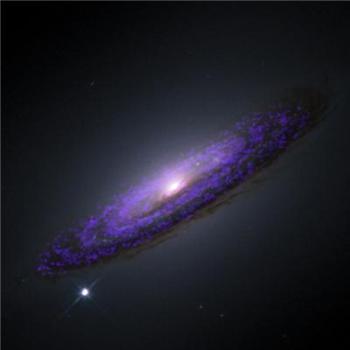Feb 1 2013
In a letter to Nature, an international team of astronomers, including Marc Sarzi from the University of Hertfordshire, report the exciting discovery of a new way to measure the mass of supermassive black holes in galaxies. By measuring the speed with which carbon monoxide molecules orbit around such black holes, this new research opens the possibility of making these measurements in many more galaxies than ever before.
 Image of Galaxy NGC4526 - the purple areas show the cold molecular gas which coincides with the dusty disk
Image of Galaxy NGC4526 - the purple areas show the cold molecular gas which coincides with the dusty disk
A black hole is an object so dense that its gravity prevents anything, including light, from escaping. Supermassive black holes can be as much as a million to a billion times more massive than our Sun, and it is believed that most, if not all galaxies including the Milky Way, contain supermassive black holes at their centres - suggesting that the evolution of black holes and galaxies is very tightly linked.
Understanding the formation of the first galaxies, the way galaxies change over time, and the processes that have generated the variety of structures observed in nearby galaxies is one of the most active research areas in astrophysics.
Marc Sarzi, from the University of Hertfordshire’s Centre for Astrophysics Research, said: “There is an intriguing link between the mass of supermassive black holes and the mass of their host galaxies, but this is based only on quite a small number of estimates. Until now only three methods were used to measure the mass of supermassive black holes and these only work on relatively nearby galaxies. With this new technique, we have been able to show that we can measure black hole masses much further out in the universe, which will help understanding the role that supermassive black holes played during the formation of galaxies.”
Tim Davis, lead author of the paper and from the European Southern Observatory, commented: “We observed carbon monoxide molecules in the galaxy we were monitoring using the Combined Array for Research in Millimeter-wave Astronomy (CARMA) telescope. With its super-sharp images we were able to zoom right into the centre of the galaxy and observe the gas whizzing around the black hole. This gas moves at a speed which is determined by the black-hole’s mass, and the distance from it. By measuring the velocity of the gas at each position, we can measure the mass of the black hole.”
The CARMA observations were rather challenging, but the new ALMA (Atacama Large Millimeter/submillimeter Array) telescope currently being built in Chile will allow this new technique to be applied more routinely to hundreds of galaxies in the nearby Universe.